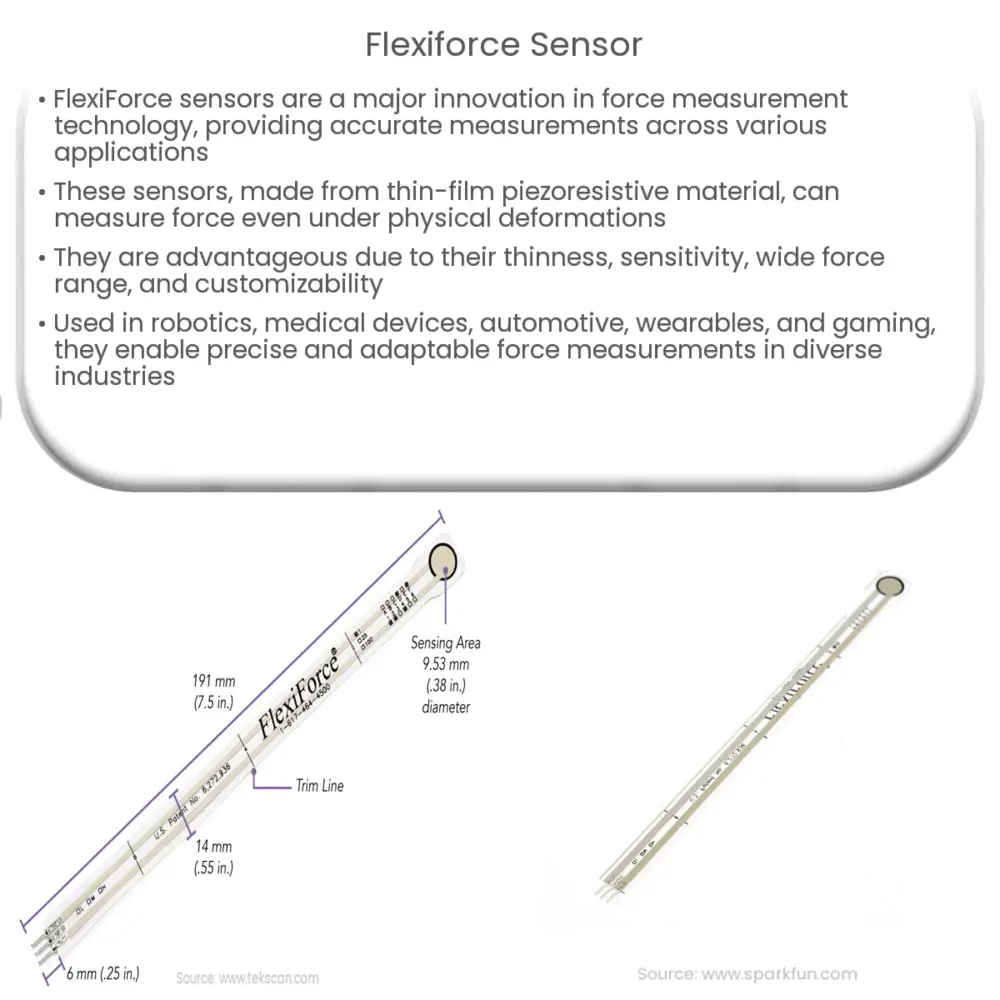FlexiForce sensors are thin, flexible piezoresistive devices that accurately measure force in various applications, from robotics to wearables.

FlexiForce Sensors: Revolutionizing Force Measurement
FlexiForce sensors are a groundbreaking innovation in the field of force measurement technology. These thin, flexible sensors are designed to measure force accurately and reliably across a wide range of applications. In this article, we will discuss the fundamentals of FlexiForce sensors, their working principles, and their various applications in industries and everyday life.
What are FlexiForce Sensors?
FlexiForce sensors are piezoresistive devices made from a flexible, thin-film material that allows them to detect and measure force applied to their surface. They are sometimes referred to as force-sensitive resistors (FSRs) or pressure-sensitive sensors. These sensors have a unique ability to accurately measure force even when subjected to bending, twisting, or other physical deformations, making them an ideal choice for applications where conventional force measurement devices may not be suitable.
How Do FlexiForce Sensors Work?
At the heart of a FlexiForce sensor is a piezoresistive material sandwiched between two thin-film layers. When force is applied to the sensor, the resistance of the piezoresistive material changes. This change in resistance is proportional to the applied force, allowing the sensor to generate an output voltage that can be measured and calibrated to determine the actual force value.
FlexiForce sensors typically have a force range of 0 to 25 lbs (0 to 110 N), although some models can measure forces up to 100 lbs (445 N) or more. The output voltage range is usually 0 to 5 V, with higher voltages corresponding to higher forces. This makes them compatible with most data acquisition systems, microcontrollers, and other electronic devices.
Advantages of FlexiForce Sensors
FlexiForce sensors offer several unique advantages over traditional force measurement devices, such as load cells and strain gauges. Some of these benefits include:
- Thin and Flexible: FlexiForce sensors are incredibly thin, typically just 0.008 inches (0.203 mm) thick, making them easy to integrate into various applications without significantly affecting the overall design.
- High Sensitivity: These sensors can detect even minute changes in force, enabling them to be used in applications where precise force measurement is essential.
- Wide Force Range: FlexiForce sensors can measure forces from a few grams to hundreds of pounds, making them suitable for a broad spectrum of applications.
- Customizable: FlexiForce sensors can be tailored to specific applications by adjusting their size, shape, and force range, allowing them to be used in a wide variety of situations.
Applications of FlexiForce Sensors
FlexiForce sensors have found use in a diverse range of industries and applications, including:
- Robotics: In robotic systems, FlexiForce sensors can be used to measure grip force, enabling robots to handle objects with greater precision and sensitivity.
- Medical Devices: FlexiForce sensors are used in devices such as infusion pumps, prosthetics, and rehabilitation equipment to ensure accurate force application and monitoring.
- Automotive: These sensors can be found in automotive applications, such as brake force measurement, seat occupancy detection, and suspension systems monitoring.
- Wearable Technology: FlexiForce sensors are incorporated into smart clothing and wearables, like gloves and shoes, to provide real-time feedback on force exertion during physical activities.
- Gaming: In gaming controllers and peripherals, FlexiForce sensors enable more immersive and interactive experiences by measuring the force applied by the user.
How to Interface with FlexiForce Sensors
Interfacing with a FlexiForce sensor is relatively straightforward. You’ll need a microcontroller or data acquisition system with an analog-to-digital converter (ADC) to read the output voltage from the sensor. A simple voltage divider circuit can be used to convert the sensor’s resistance change into a measurable voltage output. For better accuracy, you may choose to use a dedicated signal conditioning circuit or module.
Once the voltage output is obtained, it can be converted into a force value using a calibration curve. Calibration is essential to ensure accurate force measurements and should be done for each specific application. Calibration typically involves applying known forces to the sensor and recording the corresponding output voltages. This data can then be used to create a calibration curve, which is used to convert the sensor’s output voltage into a force value.
Conclusion
FlexiForce sensors have revolutionized the field of force measurement, offering a highly sensitive, flexible, and customizable solution for a wide range of applications. Their thin and adaptable nature allows them to be integrated into numerous industries, including robotics, medical devices, automotive, wearable technology, and gaming. By understanding the principles behind these sensors and how to interface with them, engineers and developers can harness their full potential to create innovative and effective solutions.

